标签:
1.说明
本章主要对ASP.NET5默认创建的项目结构及主要代码进行简单介绍。
如下图,只是把GiveCase.Web项目中的Models,ViewModels,Services文件夹分离成单独的类库项目。
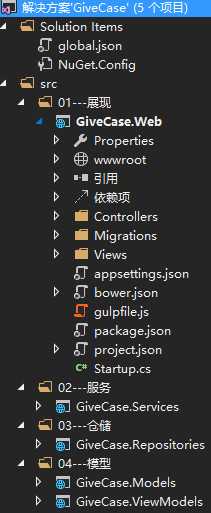
2.json文件配置
global.json
{ "projects": [ "src", "test" ], "sdk": { "version": "1.0.0-beta8" } }
projects:指定哪些文件夹包含源代码的解决方案。默认放置在 src 文件夹中。在磁盘目录:

sdk:指定的dnx版本。使用 VS2015打开解决方案时,它的设置在这里,而不是在 project.json,以统一解决方案中的不同项目针对不同版本的 SDK 的场景。
appsettings.json
{ "Data": { "DefaultConnection": { "ConnectionString": "Server=(localdb)\\mssqllocaldb;Database=TestDB;Trusted_Connection=True;MultipleActiveResultSets=true" } } }
配置数据库连接字符串文件。你也可以添加别的节点。类似传统的config.xml配置文件。
注:读写json文件的节点操作,需要引入:"Microsoft.Framework.Configuration.Json": "1.0.0-beta8"。
bower.json
{ "name": "ASP.NET", "private": true, "dependencies": { "bootstrap": "3.0.0", "bootstrap-touch-carousel": "0.8.0", "hammer.js": "2.0.4", "jquery": "2.1.4", "jquery-validation": "1.11.1", "jquery-validation-unobtrusive": "3.2.2" } }
它是基于npm中一种前端工具。通过配置dependencies后,保存bower.json文件,就可以自动下载安装包。
下载后成功后,会在这里显示:
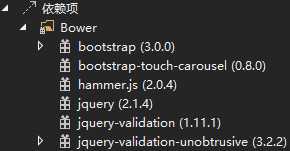
也默认安装到wwwroot/lib目录中。那么说,如何更改默认安装目录?
打开.bowerrc文件,修改即可:

同理通过配置也能自动卸载(删除)。总之是非常方便的js和css安装包管理工具。
package.json
{ "name": "ASP.NET", "version": "0.0.0", "devDependencies": { "gulp": "3.8.11", "gulp-concat": "2.5.2", "gulp-cssmin": "0.1.7", "gulp-uglify": "1.2.0", "rimraf": "2.2.8" } }
通过devDependencies配置,就安装一些npm插件工具到这里:
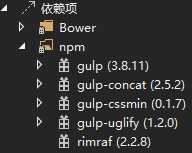
当然要使用这些工具,还有一个“任务运行程序资源管理器”要配置,右键gulpfile.js文件:
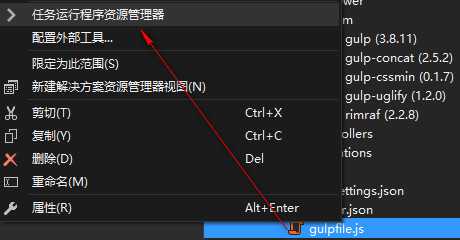
而gulpfile.js文件是配置这些工具的功能。
由于vs集成这些,使得使用npm工具学习成本太低了。给个赞吧!
另外,你也可能使用类似的grunt工具。添加:
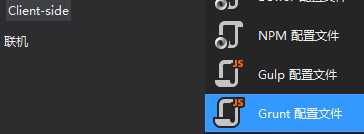
关于这些工具的js配置的功能:压缩,合并js和css文件,编译less,sass,也可以压缩html和转换图片等。后续另开文章再补充。
project.json
{ "webroot": "wwwroot", "userSecretsId": "aspnet5-GiveCase.Web-d44a8944-aefb-4275-bd5b-3f2acfb7945f", "version": "1.0.0-*", "dependencies": { "GiveCase.Models": "" //...... }, "commands": { "web": "Microsoft.AspNet.Server.Kestrel", "ef": "EntityFramework.Commands" }, "frameworks": { "dnxcore50": { "dependencies": { "EntityFramework.Commands": "7.0.0-beta8" //...... } } }, "exclude": [ "wwwroot", "node_modules" ], "publishExclude": [ "**.user", "**.vspscc" ], "scripts": { "prepublish": [ "npm install", "bower install", "gulp clean", "gulp min" ] } }
dependencies:配置依赖项目,也可以放在"frameworks":{"dnxcore50":{""}}中。
commands:dnx执行配置,如这里 dnx web执行后,就自托管运行项目起来。
frameworks:配置使用那种clr,可以多种共存。会在这里显示:

exclude:我也没明白啥意思。如果显示项目所有文件:
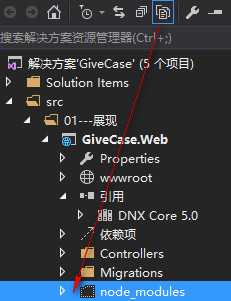
publishExclude:我也是不明白。
scripts:这个应该跟npm配置有关了。
3.文件夹
wwwroot:这个静态文件存放的地方,项目发布后也有的目录。IIS部署时,它也是网站的根目录。放置此目录以外的静态文件,是不能访问的。这是mvc机制啦。
Controllers:控制器
Views:视图
Models:模型,单独分离到Givecase.Models项目中
Models:视图模型,单独分离到Givecase.ViewModels项目中
Services: 服务(通常封装业务逻辑服务类),单独分离到Givecase.Services项目中
4.Startup.cs
粗略见代码中英文注释:
public class Startup { /// <summary> /// 构造函数 /// </summary> /// <param name="env">提供对运行主机信息的访问接口</param> /// <param name="appEnv">提供对应用程序信息的访问接口</param> public Startup(IHostingEnvironment env, IApplicationEnvironment appEnv) { // Setup configuration sources. var builder = new ConfigurationBuilder() //设置获取到应用程序基目录 .SetBasePath(appEnv.ApplicationBasePath) //将JSON配置提供程序的路径添加到configurationBuilder。 .AddJsonFile("appsettings.json") //绝对路径或相对于IConfigurationBuilder.BasePath的configurationBuilder 的路径。 //确定是否加载配置提供程序是可选的。 .AddJsonFile($"appsettings.{env.EnvironmentName}.json", optional: true); //检查当前宿主环境的名称是开发环境 if (env.IsDevelopment()) { // This reads the configuration keys from the secret store. // For more details on using the user secret store see http://go.microsoft.com/fwlink/?LinkID=532709 builder.AddUserSecrets(); } builder.AddEnvironmentVariables(); Configuration = builder.Build(); } public IConfigurationRoot Configuration { get; set; } // This method gets called by the runtime. Use this method to add services to the container. /// <summary> /// 配置服务 /// </summary> /// <param name="services">服务集合接口</param> public void ConfigureServices(IServiceCollection services) { // Add Entity Framework services to the services container. services.AddEntityFramework() .AddSqlServer() .AddDbContext<ApplicationDbContext>(options => options.UseSqlServer(Configuration["Data:DefaultConnection:ConnectionString"])); // Add Identity services to the services container. services.AddIdentity<ApplicationUser, IdentityRole>() .AddEntityFrameworkStores<ApplicationDbContext>() .AddDefaultTokenProviders(); // Add MVC services to the services container. services.AddMvc(); // Uncomment the following line to add Web API services which makes it easier to port Web API 2 controllers. // You will also need to add the Microsoft.AspNet.Mvc.WebApiCompatShim package to the ‘dependencies‘ section of project.json. // services.AddWebApiConventions(); // Register application services. services.AddTransient<IEmailSender, AuthMessageSender>(); services.AddTransient<ISmsSender, AuthMessageSender>(); } // Configure is called after ConfigureServices is called. /// <summary> /// /// </summary> /// <param name="app"></param> /// <param name="env"></param> /// <param name="loggerFactory"></param> public void Configure(IApplicationBuilder app, IHostingEnvironment env, ILoggerFactory loggerFactory) { loggerFactory.MinimumLevel = LogLevel.Information; loggerFactory.AddConsole(); loggerFactory.AddDebug(); // Configure the HTTP request pipeline. // Add the following to the request pipeline only in development environment. if (env.IsDevelopment()) { app.UseBrowserLink(); app.UseDeveloperExceptionPage(); app.UseDatabaseErrorPage(DatabaseErrorPageOptions.ShowAll); } else { // Add Error handling middleware which catches all application specific errors and // sends the request to the following path or controller action. app.UseExceptionHandler("/Home/Error"); } // Add the platform handler to the request pipeline. app.UseIISPlatformHandler(); // Add static files to the request pipeline. app.UseStaticFiles(); // Add cookie-based authentication to the request pipeline. app.UseIdentity(); // Add and configure the options for authentication middleware to the request pipeline. // You can add options for middleware as shown below. // For more information see http://go.microsoft.com/fwlink/?LinkID=532715 //app.UseFacebookAuthentication(options => //{ // options.AppId = Configuration["Authentication:Facebook:AppId"]; // options.AppSecret = Configuration["Authentication:Facebook:AppSecret"]; //}); //app.UseGoogleAuthentication(options => //{ // options.ClientId = Configuration["Authentication:Google:ClientId"]; // options.ClientSecret = Configuration["Authentication:Google:ClientSecret"]; //}); //app.UseMicrosoftAccountAuthentication(options => //{ // options.ClientId = Configuration["Authentication:MicrosoftAccount:ClientId"]; // options.ClientSecret = Configuration["Authentication:MicrosoftAccount:ClientSecret"]; //}); //app.UseTwitterAuthentication(options => //{ // options.ConsumerKey = Configuration["Authentication:Twitter:ConsumerKey"]; // options.ConsumerSecret = Configuration["Authentication:Twitter:ConsumerSecret"]; //}); // Add MVC to the request pipeline. app.UseMvc(routes => { routes.MapRoute( name: "default", template: "{controller=Home}/{action=Index}/{id?}"); // Uncomment the following line to add a route for porting Web API 2 controllers. // routes.MapWebApiRoute("DefaultApi", "api/{controller}/{id?}"); }); } } }
5.小结
目录结构简单了解到这里。我也是边学习边记笔记…… 文章主题已经标注为浅析,符合题目啦!
标签:
原文地址:http://www.cnblogs.com/givecase/p/4895366.html